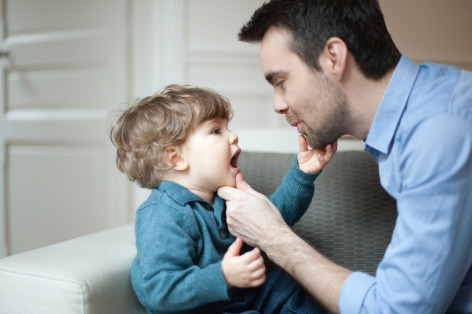
Several children with autism spectrum disorder (ASD) show developmental differences, especially in their communication and social abilities when they are toddlers. However, since they tend to crawl and walk on time, similar to peers of their age, less evident inconsistencies in behaviors, gestures, expressions, as well as language delays, often remain unnoticed. In addition to speech and interactive differences, parents may also notice abnormalities in the way their child interacts with other kids and family members.
While the signs and symptoms of autism spectrum disorder differ, their effects also vary from one child to another. For instance, some children diagnosed with autism may only suffer from mild or minor impairments, whereas the others are likely to face significantly more challenges, especially in terms of developmental milestones. However, every child on the autism spectrum may experience problems to a certain degree, primarily in areas such as verbal and non-verbal communication, relating and interacting with their surroundings, as well as behavioral and emotional complications.
How to distinguish a child with ASD from other typically developing kids?
As a parent or caretaker, you are in one of the best positions to identify the earliest and even the most unnoticed warning signs of autism spectrum disorder. Children with typical patterns of development eagerly respond to social bids, such as waving ‘bye-bye’ while leaving or looking at where you are pointing. But, children with autism tend to look at your hand instead of where you’re pointing and rarely respond to social interaction bids.
Since you understand your child and their behavioral patterns better, you are more likely to spot discrepancies others may fail to see. As a result, it is imperative that you pay close attention to if or when your child accomplishes important emotional, social, and cognitive markers to effectively identify the problem at the earliest. However, it is also important to note that developmental delays might not only point to autism spectrum disorder but also specify a heightened risk. And here, the key is to inform and educate yourself to understand what’s typical and what’s unusual when it comes to your little one –
Social & Communication Differences:
- Lack of interest in communicating or continuing a conversation
- Less likely to point to objects or people
- Unresponsive to their name being called
- Little to no eye contact
- Not talking as much as their peers
- Difficulty in making friends
- Unusual gaze or vision — might view objects from atypical angles
- Highly sensitive or insensitive to sounds, odors, lights, and touch
- Prefers repetitive routines and rituals (stimming) – apprehensive toward change
- Anxious about social situations

The earliest signs of autism may unfold between 9 to 16 months and can be fairly easy to miss. However, if not caught early, these symptoms can have an adverse impact on cognitive development, resulting in language, social, and behavioral deficits. Moreover, in certain cases, the earliest symptoms of autism can even be misread as signs of a ‘good child’ since the baby may appear undemanding, silent, and independent.
So, when you know what exactly to look for, you can effectively catch the warning signs early on – since they don’t involve the presence of atypical behaviors, but instead, the absence of typical ones –
- 6 – 9 Months – Children with autism spectrum disorder may not smile or show other joyful emotions that others babies their age tend to express. On the other hand, some children may show minimal facial expressions and smile very rarely, which could be an early sign of autism.
- 9 – 12 Months – A typically developing baby will turn when its name is called. Children with ASD, however, may not turn to respond even when their name is repeated multiple times. Babies are generally motivated to look at faces, but if it’s difficult to get your child to look at you, this is likely an early indication of autism.
- 12 – 18 Months – By this age, a typically developing child begins to ‘baby talk’ or babble in order to communicate, but this milestone will likely be hampered in children with autism. Moreover, there can also be an absence of back-and-forth gestures, including waving or pointing. They may also be unable to make up for the delay in talking or confine their speech to repeating words heard within their immediate surroundings.
- 18 – 24 Months – Babies learn to use words, sounds and gestures to let parents know what they want or don’t want. Children are also eager to interact with objects and people as a way to communicate or even garner attention. Since they are now capable of shifting their attention from one setting to another, this creates numerous opportunities for learning from social interactions. However, if your child insists on particular things being the same and tends to become really upset and agitated over unexpected changes or if it is difficult for him or her to use gestures as well as sounds while looking at you at the same time, these aspects could be a strong indication of autism spectrum disorder.
As concerned parents, you may have been asked not to worry or to even wait it out. However, waiting could by far be the most unhelpful thing to do, given the risk of losing crucial time at a tender age when your little one may have the best possible chances of improvement. Besides, it is highly unlikely that your kid might ‘grow out’ of the problems and challenges they face, whether caused by autism or other developmental concerns. And in this case, your child might require additional assistance as well as targeted treatments and therapies for autism, such as applied behavior analysis (ABA), cognitive behavior therapy (CBT), and early intervention.
Although every child develops at a pace different from the others, take a breather before you panic or worry if your kid is delayed to some extent in walking, talking, or reaching other developmental milestones. Nevertheless, if you do suspect a problem, make sure you share your concerns and apprehensions with your child’s pediatrician immediately – do not try out the ‘wait-and-watch’ approach. Sometimes, even doctors who mean well can misread red flags or under-evaluate the problem. So, make sure you listen to your instincts when you feel something is wrong, and continue to be persistent in seeking a second opinion or scheduling an appointment with a developmental specialist.
For more information, get in touch with our behavior analysts and trained professionals right here. We’re happy to assist you regarding any concerns you have about your child’s development needs and provide you with the best possible treatment options!

